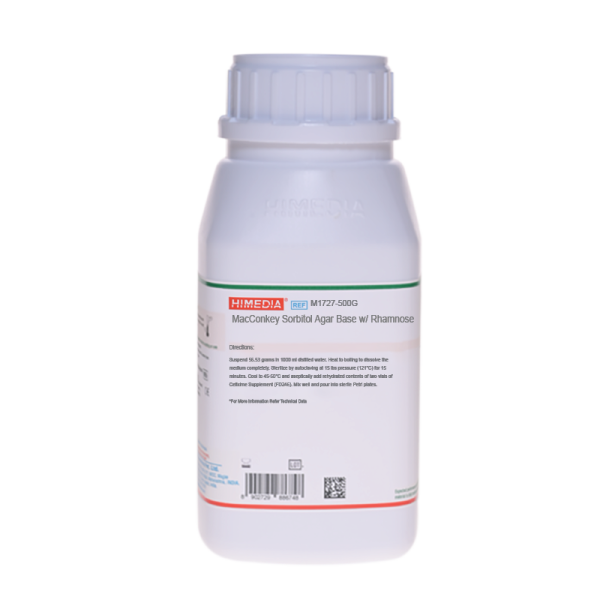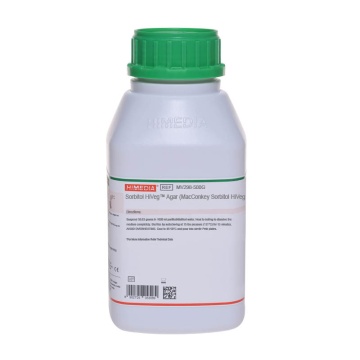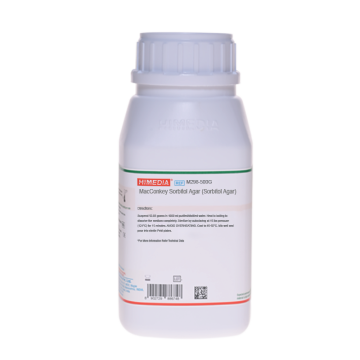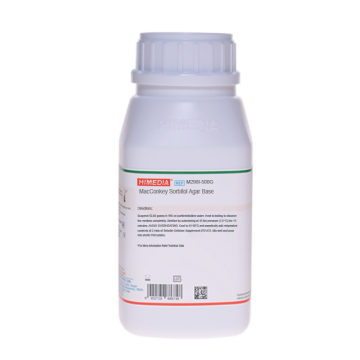 Your enquiry has been submitted
Your enquiry has been submitted
MacConkey Sorbitol Agar Base w/ Rhamnose
Intended Use
Recommended for improved differentiation of Escherichia coli O157:H7 from background flora.
Composition**
| Ingredients | g / L |
|---|---|
| Peptone | 20.000 |
| Rhamnose | 5.000 |
| D-Sorbitol | 10.000 |
| Bile salts mixture | 1.500 |
| Sodium chloride | 5.000 |
| Neutral red | 0.030 |
| Crystal violet | 0.001 |
| Agar | 15.000 |
Final pH ( at 25°C) 7.1±0.2
**Formula adjusted, standardized to suit performance parameters
Directions
Suspend 56.53 grams in 1000 ml purified / distilled water. Heat to boiling to dissolve the medium completely. Sterilize by autoclaving at 15 lbs pressure (121°C) for 15 minutes. Cool to 45-50°C and aseptically add rehydrated contents of 2 vials of Cefixime Supplement (FD246). Mix well and pour into sterile Petri plates.
Principle And Interpretation
E.coli O157:H7 is a human pathogen associated with hemorrhagic colitis that results from the action of a shiga-like toxin (4,8). MacConkey agars are selective media and recommended as differential plating media for detection and isolation of coliforms from various samples clinical, dairy, food, water, pharmaceuticals etc.(3). Of different E.coli strains, E.coli O157:H7 which is a hemorrhagic strain does not ferment sorbitol or rhamnose (3,10). This biochemical feature aids in differentiating E.coli O157:H7 from other E.coli strains. Generally on standard MacConkey Agar medium containing lactose, this strain cannot be differentiated from other lactose fermenting E.coli. Rhamnose is often fermented by most sorbitol negative Escherichia coli of other serogroups (5).
MacConkey Sorbitol Agar Base w/ Rhamnose contains two sugars as sorbitol and rhamnose. Since E.coli O157:H7 do not usually ferment sorbitol or rhamnose it appears as colourless to straw coloured colonies. While rhamnose positive and sorbitol negative appear as pink or red coloured colony and it should not be counted as presumptive Escherichia coli O157:H7. MacConkey Sorbitol Agar Base w/ Rhamnose contains peptone in the medium which supplies necessary nutrients to growing cells. Crystal violet and bile salts mixture present in the medium inhibits growth of gram positive bacteria. Addition of cefixime significantly reduces the number of sorbitol nonfermentors that are to be screened during the attempted isolation of E.coli O157: H7. The isolated suspected colonies of E.coli O157: H7 obtained on this medium can be further confirmed using the LK13 E.coli Latex Test kit.
Type of specimen
Clinical samples - faeces, urine, pus; Food and dairy samples; Water samples
Specimen Collection and Handling
For clinical samples follow appropriate techniques for handling specimens as per established guidelines (6,7). For food and dairy samples, follow appropriate techniques for sample collection and processing as per guidelines (1,9,11). For water samples, follow appropriate techniques for sample collection, processing as per guidelines and local standards(2). After use, contaminated materials must be sterilized by autoclaving before discarding.
Warning and Precautions
In Vitro diagnostic Use only. Read the label before opening the container. Wear protective gloves/protective clothing/eye protection/ face protection. Follow good microbiological lab practices while handling specimens and culture. Standard precautions as per established guidelines should be followed while handling clinical specimens. Safety guidelines may be referred in individual safety data sheets.
Limitations
- Some E.coli O157:H7 are rhamnose positive and sorbitol negative, and appear as pink or red coloured colony and it should not be counted as presumptive Escherichia coli O157:H7.
- Further biochemical and serological testing is required for complete identification.
Performance and Evaluation
Performance of the medium is expected when used as per the direction on the label within the expiry period when stored at recommended temperature.
Quality Control
Appearance
Light yellow to pink homogeneous free flowing powder
Gelling
Firm, comparable with 1.5% Agar gel.
Colour and Clarity of prepared medium
Purplish red coloured, clear to slightly opalescent gel forms in Petri plates
Reaction
Reaction of 5.65% w/v aqeuous solution at 25°C. pH : 7.1±0.2
pH
6.90-7.30
Cultural Response
Cultural characteristics observed after an incubation at 35-37°C for 18- 24 hours.
| Organism | Inoculum (CFU) | Growth | Recovery | Colour of Colony |
|---|---|---|---|---|
| Escherichia coli O157:H7 (NCTC 12900) (0004*) | 50-100 | good-luxuriant | >=50% | Colourless to straw |
| Escherichia coli ATCC 25922 (00013*) | 50-100 | good-luxuriant | >=50% | Pink to red |
| Proteus mirabilis ATCC 29906(00023*) | >=104 | inhibited | 0% |
Key : (*) Corresponding WDCM numbers.
Storage and Shelf Life
Store between 10-30°C in a tightly closed container and the prepared medium at 2-8°C. Use before expiry date on the label. On opening, product should be properly stored dry, after tightly capping the bottle in order to prevent lump formation due to the hygroscopic nature of the product. Improper storage of the product may lead to lump formation. Store in dry ventilated area protected from extremes of temperature and sources of ignition. Seal the container tightly after use. Product performance is best if used within stated expiry period.
Disposal
User must ensure safe disposal by autoclaving and/or incineration of used or unusable preparations of this product. Follow established laboratory procedures in disposing of infectious materials and material that comes into contact with clinical sample must be decontaminated and disposed of in accordance with current laboratory techniques (6,7).
Reference
- American Public Health Association, Standard Methods for the Examination of Dairy Products, 1978, 14th Ed., Washington D.C.
- Baird R.B., Eaton A.D., and Rice E.W., (Eds.), 2015, Standard Methods for the Examination of Water and Wastewater, 23rd ed., APHA, Washington, D.C.
- Bopp, Brenner, Wells and Stockbine. 1999. In Murray, Baron, Rfaller, Tononcer and Yolken (ed.) Manual of Clinical Microbiology, 7th ed. American Society for Microbiology, Washington, DC.
- Centre for Diseases control. 1991. Morbid. Mortal. Weekly Rep 40:265.
- Chapman, P.A., Siddons, C.A., Zadik, P.M and Jewes L. (1991). J Med Microbiol 35: 155
- Isenberg, H.D. Clinical Microbiology Procedures Handbook 2nd Edition.
- Jorgensen, J.H., Pfaller, M.A., Carroll, K.C., Funke, G., Landry, M.L., Richter, S.S and Warnock., D.W. (2015) Manual of Clinical Microbiology, 11th Edition. Vol. 1.
- March and Ratnam 1986.J. Clin Microbiol, 23:869.
- Salfinger Y., and Tortorello M.L. Fifth (Ed.), 2015, Compendium of Methods for the Microbiological Examination of Foods, 5th Ed., American Public Health Association, Washington, D.C.
- Sanderson, Gay, Hancock, Gay, Fox and Besser, 1955. J Clin Microbiol. 33: 2616.
- Wehr H. M. and Frank J. H., 2004, Standard Methods for the Microbiological Examination of Dairy Products, 17th Ed., APHA Inc., Washington, D.C.
| Product Name | MacConkey Sorbitol Agar Base w/ Rhamnose |
|---|---|
| SKU | M1727 |
| Product Type | Regular |
| Physical Form | Powder |
| Origin | Animal |
| Packaging type | HDPE |
| References | 1. American Public Health Association, Standard Methods for the Examination of Dairy Products, 1978, 14th Ed., Washington D.C. |
| Customized Product Available | No |










